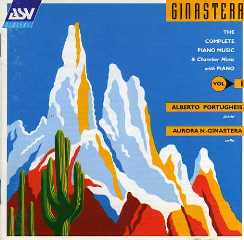Alberto Ginastera - The Complete Piano and Chamber Music Vol.1 (1993)
Alberto Ginastera - The Complete Piano and Chamber Music Vol.1 (1993)

1 – 3 Danzas Argentinas op.2
4 Pequena Danza
5 – 16 12 American Preludes op.12
17 – 20 Piano Sonata no,1 op.22
21 Pampeana no.2 op.21
22 Triste
23 – 26 Sonata for Cello and Piano op.49
Alberto Portugheis – piano
Aurora Natola-Ginastera – cello
Few composers have had the good fortune to be married to a performer of world class who has become a leading exponent of their music. Messiaen was one of that rare company: so was Ginastera, whose two cello concertos and fantastically difficult cello sonata were written for his wife Aurora Natola, whom he had first met in 1950 when the young virtuoso had won a Buenos Aires award playing his Pampeana No. 2. That is a rhapsodic showpiece with several solo cadenzas (beautifully shaped here), and features strongly rhythmic ostinatos of nationalist colouring: similar violently accented repetitive rhythms characterize most of the earlier works for piano here—many of the miniature American Preludes, the wild little dance transcribed from the ballet Estancia, the first and third of the Danzas argentinas—along with polytonality, block chords of piled-up fourths and tone-clusters. Alberto Portugheis is brilliantly fiery in all of these, but equally he brings seductive nuances to the languid second Argentine dance, a sensitivity matched by Natola in the affecting short Triste (a song transcription).
The principal works on this disc are the two sonatas. That for piano (1952) shows some stylistic development in its ghostly flitting scherzo and desolate Adagio (both of which toy with dodecaphony). The work has already established itself in the repertoire—there have been previous recordings—and Portugheis's reading is suitably intense and, where required, ferociously rhythmic: I would mildly question only a few Luftpausen at the ends of bars in passages widely extended over the keyboard. He has a splendid duo partner in the much later (1979) and exceptionally demanding Cello Sonata the most remarkable movement of which is the palindromic Presto, full of bizarre effects that seem to reflect Ginastera's enthusiasm for the paintings of Paul Klee. Outstandingly good recorded quality. -- Lionel Salter, Gramophone [10/1993]
download: uploaded anonfiles yandex 4shared solidfiles mediafire mega filecloudio
Last Updated (Friday, 22 November 2013 14:45)








